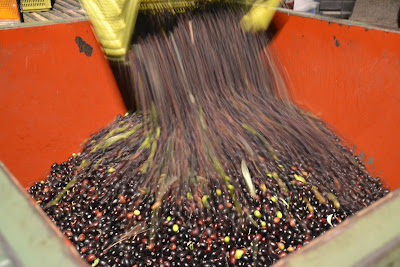I wish I had an Olive Grove
I really do. Two short sessions of picking those plump oval fruits on a hillside overlooking Livorno were sufficient to persuade me that I could get quite used to living the peaceful, rural life, taking care of trees and plants, picking the fruits and making olive oil. Well, I wouldn't be making the olive oil myself, of course. I would load all my olives into my car and set off for my local olive press, or frantoio, just as I did this week with my friend Jessica who really does have an olive grove all of her own (see previous article).
I'd never seen an olive press in operation before. I once had the misfortune to rent a room in Greece above an olive mill - the old-fashioned type with a huge grindstone that shook the floor as it turned, very early in the mornings. I never quite understood why they were pressing olives in April, though.
Here in Italy the olive harvest takes place between October and December. We took Jessica's 500+ kilos of olives to the De Laurentiis press near Luciana, just over the provincial border between Livorno and Pisa. We had an appointment for 6pm and were on time, but they were running late, inevitably: there is a good harvest this year and people had been turning up with much more than they had predicted. Several other customers were hanging around waiting patiently for their turn, while one man dressed in khaki sweat shirt and combat trousers surveyed a constant stream of green oil - his own - that was pouring out of the huge pressing machine and being decanted into stainless steel containers that look a bit like milk churns and hold 50 litres of the miraculous liquid. How satisfying that must be!
It takes approximately 10kg of olives to get a litre of oil. Most frantoi accept a minimum of 100kg (1 quintale) and charge around 15 euros for this amount. These small, family-run businesses operate for around three months a year (Oct-Dec) and are open from early in the morning to midnight during this peak time.
As we waited, there was chat about possible yield, optimum ripeness and the maximum time you should allow to lapse between picking and pressing - about 4 days. Olive farmers compared notes on the location of their trees, and on previous years' harvests.

Meanwhile, I watched with fascination as the machinery turned the olives into oil, first stripping them of any leaves, then washing and mashing the fruits and finally extracting the precious liquid. Although the machinery is modern, with no grindstones in sight, it is still noisy and the operators wore ear protection. The deliciously pungent perfume of olives filled the air, in anticipation of the spicy taste of the new oil. I couldn't wait to get home to try some, drizzled on Tuscan bread.
Jessica's land, and its 90 olive trees, is currently for sale. Sadly I can't afford it, but if you are interested and would like further information, please contact me.
The De Laurentiis Frantoio is at:
Via S. Regolo 54,
Loc. Luciana
Tel. +(39) 349 7512871, fax +(39) 050 650732
email: lorenzodelau@tiscalinet.it
Related article: Olive Oil is Good for You!
Previous Blog: Pass the Space Oil!
As we waited, there was chat about possible yield, optimum ripeness and the maximum time you should allow to lapse between picking and pressing - about 4 days. Olive farmers compared notes on the location of their trees, and on previous years' harvests.

Meanwhile, I watched with fascination as the machinery turned the olives into oil, first stripping them of any leaves, then washing and mashing the fruits and finally extracting the precious liquid. Although the machinery is modern, with no grindstones in sight, it is still noisy and the operators wore ear protection. The deliciously pungent perfume of olives filled the air, in anticipation of the spicy taste of the new oil. I couldn't wait to get home to try some, drizzled on Tuscan bread.
Jessica's land, and its 90 olive trees, is currently for sale. Sadly I can't afford it, but if you are interested and would like further information, please contact me.
The De Laurentiis Frantoio is at:
Via S. Regolo 54,
Loc. Luciana
Tel. +(39) 349 7512871, fax +(39) 050 650732
email: lorenzodelau@tiscalinet.it
Related article: Olive Oil is Good for You!
Previous Blog: Pass the Space Oil!





.jpg)

Comments
Post a Comment